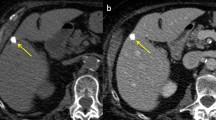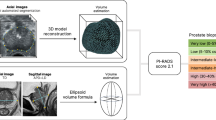Abstract
Purposes
To determine the CT features and demographic data predictive of type 2 papillary renal cell carcinoma (PRCC) that can help distinguish this neoplasm from fat-poor angiomyolipoma (fpAML) and oncocytoma.
Methods
Fifty-four patients with type 2 PRCC, 48 with fpAML, and 47 with oncocytoma in the kidney from multiple centers were retrospectively reviewed. The demographic data and CT features of type 2 PRCC were analyzed and compared with those of fpAML and oncocytoma by univariate analysis and multiple logistic regression analysis to determine the predictive factors for differential diagnosis. Then, receiver operating characteristic (ROC) curve analysis was performed to further assess the logistic regression model and set the threshold level values of the numerical parameters.
Results
Older age (≥ 46.5 years), unenhanced lesion-to-renal cortex attenuation (RLRCA) < 1.21, corticomedullary ratio of lesion to renal cortex net enhancement (RLRCNE) < 0.32, and size ≥ 30.1 mm were independent predictors for distinguishing type 2 PRCC from fpAML (OR 14.155, 8.332, and 57.745, respectively, P < 0.05 for all). The area under the curve (AUC) of the multiple logistic regression model in the ROC curve analysis was 0.970. In the combined evaluation, the four independent predictors had a sensitivity and specificity of 0.896 and 0.889, respectively. A corticomedullary RLRCNE < 0.61, irregular shape, and male sex were independent predictors for the differential diagnosis of type 2 PRCC from oncocytoma (OR 15.714, 12.158, and 6.175, respectively, P < 0.05 for all). In the combined evaluation, the three independent predictors had a sensitivity and specificity of 0.889 and 0.979, respectively. The AUC of the multiple logistic regression model in the ROC curve analysis was 0.964.
Conclusion
The combined application of CT features and demographic data had good ability in distinguishing type 2 PRCC from fpAML and oncocytoma, respectively.
Graphical abstract





Similar content being viewed by others
References
Warren AY, Harrison D (2018) WHO/ISUP classification, grading and pathological staging of renal cell carcinoma: standards and controversies. World J Urol 36 (12):1913-1926. https://doi.org/10.1007/s00345-018-2447-8.
Young JR, Margolis D, Sauk S, Pantuck AJ, Sayre J, Raman SS (2013) Clear cell renal cell carcinoma: discrimination from other renal cell carcinoma subtypes and oncocytoma at multiphasic multidetector CT. Radiology 267 (2): 444-453. https://doi.org/10.1148/radiol.13112617.
Kim SH, Kim CS, Kim MJ, Cho JY, Cho SH (2016) Differentiation of Clear Cell Renal Cell Carcinoma From Other Subtypes and Fat-Poor Angiomyolipoma by Use of Quantitative Enhancement Measurement During Three-Phase MDCT. AJR Am J Roentgenol 206 (1): W21-28. https://doi.org/10.2214/AJR.15.14666.
Moldovanu CG, Petresc B, Lebovici A, Tamas-Szora A, Suciu M, Crisan N, Medan P, Buruian MM (2020) Differentiation of Clear Cell Renal Cell Carcinoma from other Renal Cell Carcinoma Subtypes and Benign Oncocytoma Using Quantitative MDCT Enhancement Parameters. Medicina (Kaunas) 56 (11): 569. https://doi.org/10.3390/medicina56110569.
Lee-Felker SA, Felker ER, Tan N, Margolis DJ, Young JR, Sayre J, Raman SS (2014) Qualitative and quantitative MDCT features for differentiating clear cell renal cell carcinoma from other solid renal cortical masses. AJR Am J Roentgenol 203 (5): W516-524. https://doi.org/10.2214/AJR.14.12460.
Bird VG, Kanagarajah P, Morillo G, Caruso DJ, Ayyathurai R, Leveillee R, Jorda M (2011) Differentiation of oncocytoma and renal cell carcinoma in small renal masses (<4 cm): the role of 4-phase computerized tomography. World J Urol 29 (6):787-92. https://doi.org/10.1007/s00345-010-0586-7.
Pierorazio PM, Hyams ES, Tsai S, Feng Z, Trock BJ, Mullins JK, Johnson PT, Fishman EK, Allaf ME (2013) Multiphasic enhancement patterns of small renal masses (≤4 cm) on preoperative computed tomography: utility for distinguishing subtypes of renal cell carcinoma, angiomyolipoma, and oncocytoma. Urology 81 (6): 1265-1271. https://doi.org/10.1016/j.urology.2012.12.049.
Sasaguri K, Takahashi N, Gomez-Cardona D, Leng S, Schmit GD, Carter RE, Leibovich BC, Kawashima A (2015) Small (< 4 cm) Renal Mass: Differentiation of Oncocytoma From Renal Cell Carcinoma on Biphasic Contrast-Enhanced CT. AJR Am J Roentgenol 205 (5):999-1007. https://doi.org/10.2214/AJR.14.13966.
Moch H, Cubilla AL, Humphrey PA, Reuter VE, Ulbright TM (2016) The 2016 WHO Classification of Tumours of the Urinary System and Male Genital Organs-Part A: Renal, Penile, and Testicular Tumours. Eur Urol 70 (1):93-105. https://doi.org/10.1016/j.eururo.2016.02.029.
Li CX, Lu Q, Huang BJ, Wang PL, Wang WP (2021) Routine or enhanced imaging to differentiate between type 1 and type 2 papillary renal cell carcinoma. Clin Radiol 76 (2):135-142. https://doi.org/10.1016/j.crad.2020.09.020.
Yamamoto T, Gulanbar A, Hayashi K, Kohno A, Komai Y, Yonese J, Matsueda K, Inamura K (2021) Is hypervascular papillary renal cell carcinoma present? Abdom Radiol (NY) 46(4):1687-1693. https://doi.org/10.1007/s00261-020-02809-8.
Silverman SG, Israel GM, Herts BR, Richie JP (2008) Management of the incidental renal mass. Radiology 249 (1): 16-31. https://doi.org/10.1148/radiol.2491070783.
Silverman SG, Mortele KJ, Tuncali K, Jinzaki M, Cibas ES (2007) Hyperattenuating renal masses: etiologies, pathogenesis, and imaging evaluation. Radiographics 27 (4): 1131-1143. https://doi.org/10.1148/rg.274065147.
Park BK (2019) Renal Angiomyolipoma Based on New Classification: How to Differentiate It From Renal Cell Carcinoma. AJR Am J Roentgenol 212 (3): 582-588. https://doi.org/10.2214/AJR.18.20408.
Vikram R, Ng CS, Tamboli P, Tannir NM, Jonasch E, Matin SF, Wood CG, Sandler CM (2009) Papillary renal cell carcinoma: radiologic-pathologic correlation and spectrum of disease. Radiographics 29(3):741–54; discussion 755–757. https://doi.org/10.1148/rg.293085190.
Kim JI, Cho JY, Moon KC, Lee HJ, Kim SH (2009) Segmental enhancement inversion at biphasic multidetector CT: characteristic finding of small renal oncocytoma. Radiology 252 (2): 441-448. https://doi.org/10.1148/radiol.2522081180.
Zhou C, Ban X, Lv J, Cheng L, Xu J, Shen X (2022) Role of computed tomography features in the differential diagnosis of chromophobe renal cell carcinoma from oncocytoma and angiomyolipoma without visible fat. Quant Imaging Med Surg 12 (4): 2332–2343. https://doi.org/10.21037/qims-21-734.
Kim YH, Han K, Oh YT, Jung DC, Cho NH, Park SY (2018) Morphologic analysis with computed tomography may help differentiate fat-poor angiomyolipoma from renal cell carcinoma: a retrospective study with 602 patients. Abdom Radiol (NY) 43 (3): 647-654. https://doi.org/10.1007/s00261-017-1244-y.
Duan C, Li N, Niu L, Wang G, Zhao J, Liu F, Liu X, Ren Y, Zhou X (2020) CT texture analysis for the differentiation of papillary renal cell carcinoma subtypes. Abdom Radiol (NY) 45 (11): 3860-3868. https://doi.org/10.1007/s00261-020-02588-2.
Yamada T, Endo M, Tsuboi M, Matsuhashi T, Takase K, Higano S, Takahashi S (2008) Differentiation of pathologic subtypes of papillary renal cell carcinoma on CT. AJR Am J Roentgenol 191 (5): 1559-1563. https://doi.org/10.2214/AJR.07.3181.
Egbert ND, Caoili EM, Cohan RH, Davenport MS, Francis IR, Kunju LP, Ellis JH (2013) Differentiation of papillary renal cell carcinoma subtypes on CT and MRI. AJR Am J Roentgenol 201 (2): 347-355. https://doi.org/10.2214/AJR.12.9451.
Yang L, Li XM, Hu YJ, Zhang MN, Yao J, Song B (2021) Multidetector CT Characteristics of Fumarate Hydratase-Deficient Renal Cell Carcinoma and Papillary Type II Renal Cell Carcinoma. Korean J Radiol 22 (12): 1996-2005. https://doi.org/10.3348/kjr.2021.0212.
Jeong CJ, Park BK, Park JJ, Kim CK (2016) Unenhanced CT and MRI Parameters That Can Be Used to Reliably Predict Fat-Invisible Angiomyolipoma. AJR Am J Roentgenol 206 (2):340-347. https://doi.org/10.2214/AJR.15.15086.
Lim RS, Flood TA, McInnes MDF, Lavallee LT, Schieda N (2018) Renal angiomyolipoma without visible fat: Can we make the diagnosis using CT and MRI? Eur Radiol 28 (2): 542-553. https://doi.org/10.1007/s00330-017-4988-4.
Ishigami K, Jones AR, Dahmoush L, Leite LV, Pakalniskis MG, Barloon TJ (2015) Imaging spectrum of renal oncocytomas: a pictorial review with pathologic correlation. Insights Imaging 6 (1): 53-64. https://doi.org/10.1007/s13244-014-0373-x.
Funding
The authors declare no funding.
Author information
Authors and Affiliations
Corresponding author
Ethics declarations
Conflict of interest
All authors declare that they have no conflict of interests. The authors of this manuscript declare no relationships with any companies, whose products or services may be related to the subject matter of the article.
Additional information
Publisher's Note
Springer Nature remains neutral with regard to jurisdictional claims in published maps and institutional affiliations.
Rights and permissions
Springer Nature or its licensor holds exclusive rights to this article under a publishing agreement with the author(s) or other rightsholder(s); author self-archiving of the accepted manuscript version of this article is solely governed by the terms of such publishing agreement and applicable law.
About this article
Cite this article
Zhou, C., Ban, X., Luo, L. et al. The value of CT features and demographic data in the differential diagnosis of type 2 papillary renal cell carcinoma from fat-poor angiomyolipoma and oncocytoma. Abdom Radiol 47, 3838–3846 (2022). https://doi.org/10.1007/s00261-022-03644-9
Received:
Revised:
Accepted:
Published:
Issue Date:
DOI: https://doi.org/10.1007/s00261-022-03644-9




